Overview
This article is dedicated to exploring the foods that can truly make a difference in managing Type 2 diabetes. We understand that navigating this journey can be overwhelming, and we want to provide you with clear, compassionate information to support you. The focus is on the nutritional benefits of certain foods and how they can help stabilize blood sugar levels, which is so important for your health.
Among the highlighted foods are:
- Spinach
- Blueberries
- Salmon
- Quinoa
- Almonds
- Chickpeas
- Greek yogurt
- Sweet potatoes
- Cinnamon
Each of these foods has unique properties that contribute to improved insulin sensitivity and overall wellness. By incorporating them into your meals, you can take meaningful steps toward effective diabetes management.
It's understandable to feel uncertain about what to eat. Remember, you’re not alone in this journey. We are here to support you every step of the way. Consider reaching out to a healthcare professional or a nutritionist who can guide you in making these dietary changes. Together, we can work toward a healthier future.
Introduction
In the quest for effective management of Type 2 Diabetes, dietary choices play a pivotal role. It's understandable to feel overwhelmed by the abundance of information available. Identifying the right foods that can aid in blood sugar control is crucial for individuals navigating this condition. This article delves into ten specific foods that not only support glucose regulation but also enhance overall well-being. However, with so many options, how can one discern which foods truly make a difference in managing diabetes effectively? You're not alone in this journey, and we are here to support you every step of the way.
T2DSolutions: Comprehensive Resource for Type 2 Diabetes Management
At T2DSolutions, we are dedicated to empowering individuals and families affected by Type 2 Diabetes. We understand that navigating this journey can feel overwhelming, and we are here to support you every step of the way. As a newly introduced platform, T2DSolutions aims to be your primary resource center for Type 2 and Type 3 blood sugar management education and community assistance.
Our platform offers tailored information on:
- Dietary plans
- Exercise routines
- Foods that help type 2 diabetes
- The latest medical research
We believe that having access to reliable and actionable strategies is essential for managing your condition effectively. It's understandable to feel uncertain at times, but rest assured, you are not alone in this journey.
By focusing on a holistic approach that includes lifestyle changes and community support, T2DSolutions stands out as a vital resource. We encourage you to explore the wealth of information available and to connect with others who share similar experiences. Together, we can navigate the complexities of diabetes management and foster a supportive community.
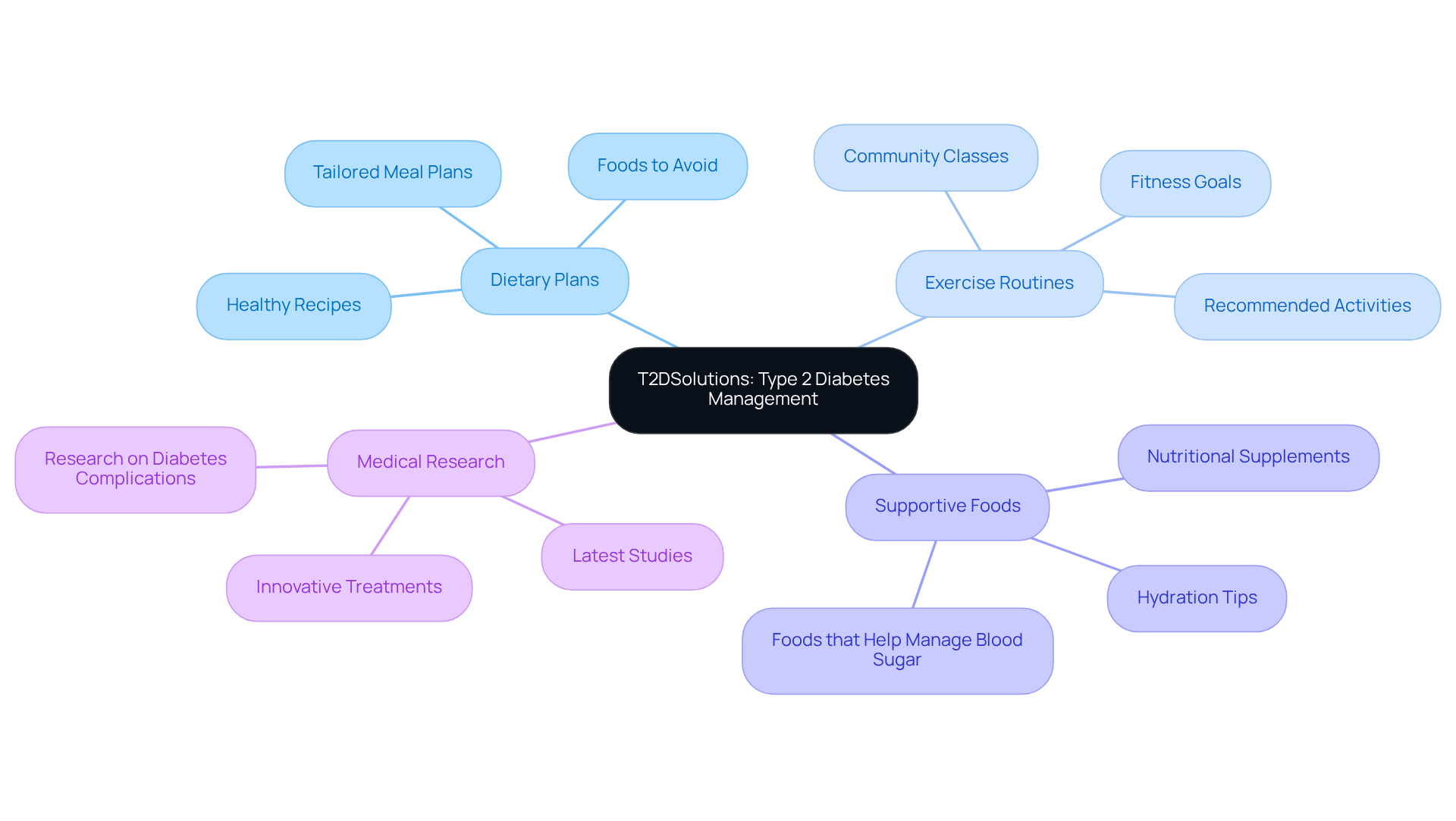
Spinach: Nutrient-Dense Leafy Green for Blood Sugar Control
Spinach is truly a powerhouse of essential nutrients, packed with vitamins A, C, and K, as well as important minerals like iron and magnesium. Just one cup of raw spinach contains a mere 0.86 calories and 29.7 mg of calcium, making it an excellent choice for those looking to manage glucose levels. With its low carbohydrate content and high fiber profile, spinach is among the foods that help type 2 diabetes and serves as a fundamental part of any diabetes-friendly meal plan.
It's understandable to feel overwhelmed by dietary choices, but studies show that regularly including foods that help type 2 diabetes, like spinach, in your diet can improve insulin sensitivity and help reduce the risk of sugar spikes. Additionally, spinach contains alpha-lipoic acid, an antioxidant that has shown promise in lowering glucose levels and enhancing insulin sensitivity in early studies.
As registered dietitian Dolores Woods wisely notes, 'The benefits of spinach outweigh the risks for people who don't need to follow a low-oxalate diet.' However, if you are someone who is prone to kidney stones or on anticoagulants, it's important to be cautious due to spinach's high oxalate content and vitamin K levels.
This nutrient-rich leafy vegetable is among the foods that help type 2 diabetes, as it supports glucose regulation and contributes to overall well-being, underscoring its importance in a balanced diet for those managing insulin sensitivity. Remember, incorporating a variety of vegetables alongside spinach is essential for meeting your overall nutritional needs. You're not alone in this journey; we are here to support you every step of the way.
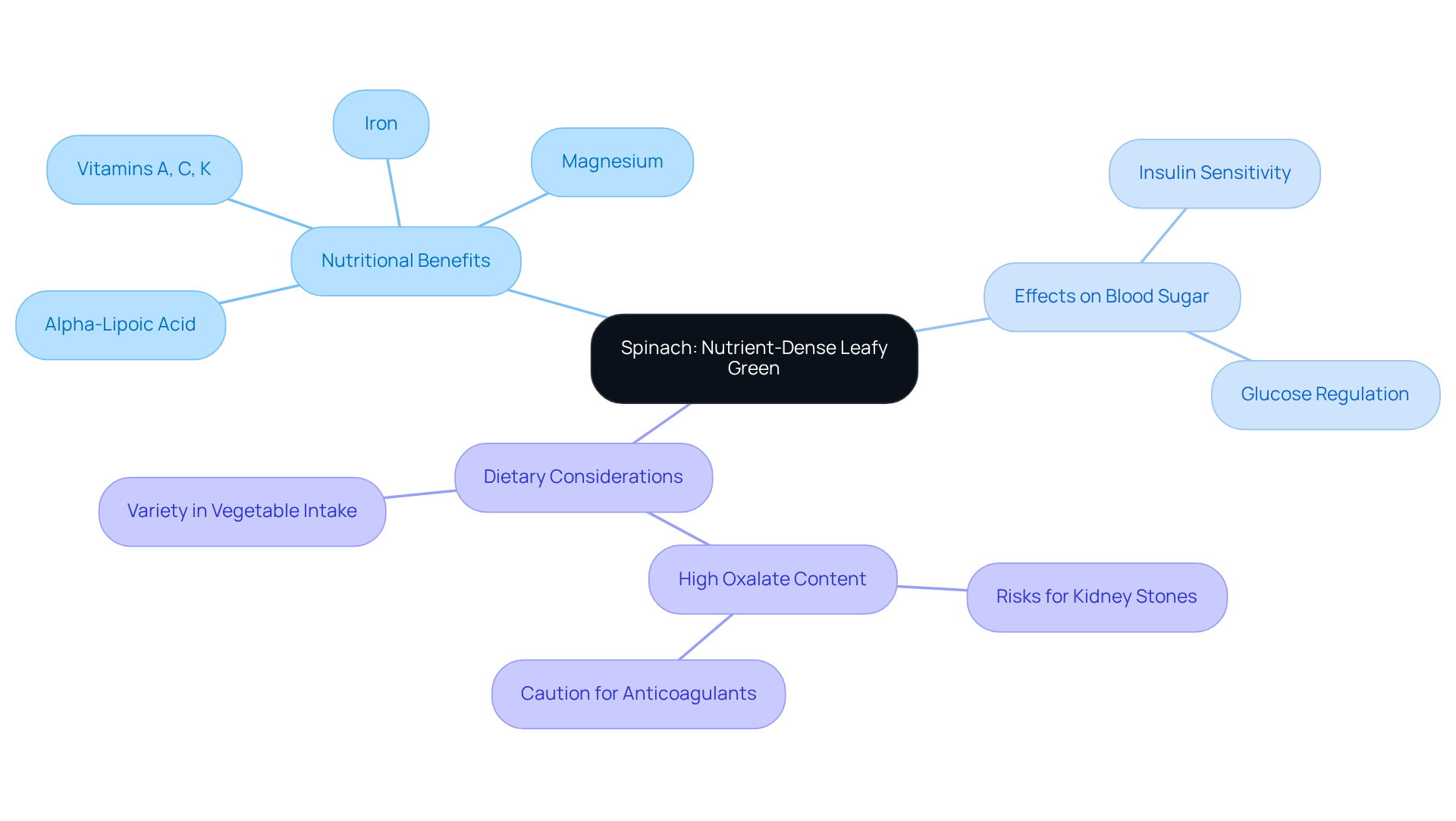
Blueberries: Antioxidant-Rich Fruit for Diabetes Management
Blueberries are not just a delightful treat; they are also a remarkable source of antioxidants and essential vitamins. With a glycemic index of 53, they are classified as foods that help type 2 diabetes, which means they won’t lead to rapid spikes in your glucose levels. Research shows that regularly enjoying foods that help type 2 diabetes, like blueberries, can significantly improve insulin sensitivity. In fact, studies indicate an increase in insulin response by as much as 1.7 mg.kg FFM(-1).min(-1) when compared to placebo groups, a change that is statistically significant (P=0.04).
One cup of fresh blueberries contains about 84 calories, making them a nutritious choice for anyone looking to manage their weight. Their rich antioxidant properties help combat oxidative stress, which is linked to various health issues, including the importance of consuming foods that help type 2 diabetes. The American Diabetes Association even recognizes blueberries as among the foods that help type 2 diabetes, referring to them as a 'diabetes superfood.' Including approximately 1 cup of fresh or frozen blueberries in your daily meals can support glucose management and is one of the foods that help type 2 diabetes as well as benefiting your overall health.
At T2DSolutions, we understand how important it is to navigate your health journey. We encourage you to explore how incorporating blueberries and other foods that help type 2 diabetes can be a vital part of your management plan. Remember, you're not alone in this journey; our resources and community are here to support you every step of the way.
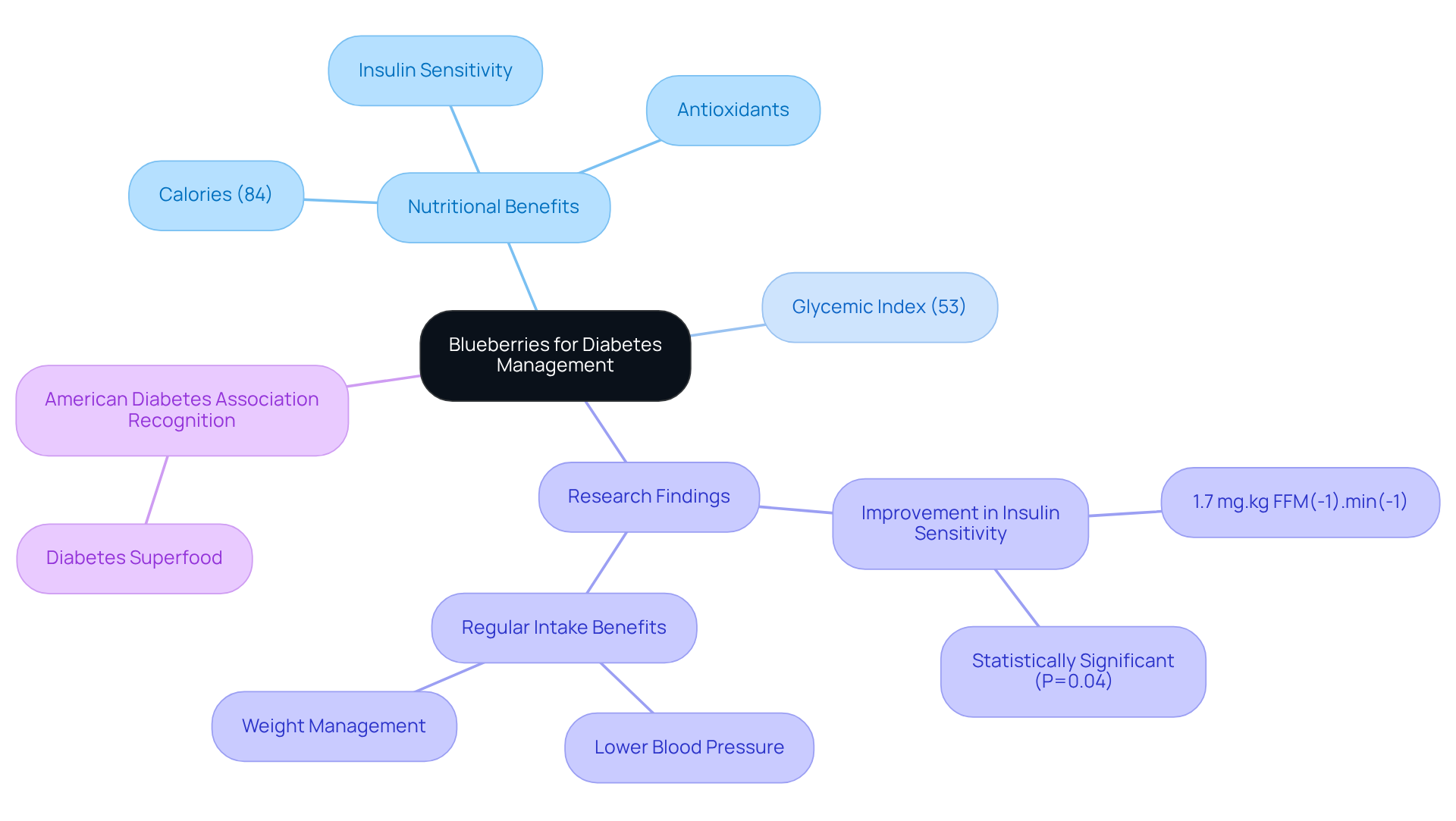
Salmon: Heart-Healthy Fatty Fish for Diabetes
Salmon is truly a nutritional powerhouse, packed with high-quality protein and omega-3 fatty acids that are essential for reducing inflammation and promoting heart health. If you're managing blood sugar issues, adding salmon and other foods that help type 2 diabetes to your diet can be a significant step toward stabilizing glucose levels while providing vital nutrients that enhance your overall well-being. Research indicates that regular consumption of certain foods that help type 2 diabetes, particularly omega-3 fatty acids from fatty fish like salmon, can improve glycemic control and lower HbA1c values. The American Diabetes Association suggests that incorporating at least two servings of fatty fish each week can be among the foods that help type 2 diabetes in order to reap these health benefits.
A single 3.5-ounce serving of salmon offers around 22 grams of protein, with farmed salmon containing about 2.3 grams of omega-3 fatty acids and wild salmon about 2.2 grams. Additionally, salmon is rich in vitamin D, which is crucial for bone health. By prioritizing salmon in your meals, you can savor its delicious flavor while also taking meaningful steps to support your health. As Ryan Raman, an MS, RD, wisely notes, "Salmon is a nutritional powerhouse that provides several impressive health benefits."
For a diabetes-friendly meal, consider grilling or baking salmon along with foods that help type 2 diabetes, such as vegetables. Remember, you’re not alone in this journey; to learn more about managing your condition effectively, visit T2DSolutions, your comprehensive resource for Type 2 and Type 3 education and community support. We are here to support you every step of the way.

Quinoa: High-Fiber Whole Grain for Stable Blood Sugar
Quinoa is a gluten-free whole grain that offers a wealth of benefits, including high fiber and protein content. It's understandable to seek foods that help type 2 diabetes as alternatives that support your health, especially when managing glucose levels. Quinoa's low glycemic index (GI) makes it a wonderful choice, as it helps maintain stable glucose levels, preventing those rapid spikes that can be concerning. Studies show that incorporating quinoa into your meals can be a nourishing and versatile option. It can be enjoyed in salads, grain bowls, or as a delightful side dish, providing a wholesome base for various culinary creations.
Moreover, quinoa is one of the foods that help type 2 diabetes, containing 2.1 grams of fiber per 100 grams, which supports digestive health and aids in glucose regulation. This makes it one of the foods that help type 2 diabetes for those managing the condition. Remember, dietary guidelines recommend that at least half of your daily grain intake come from whole grains. By choosing quinoa, you are not just enhancing your diet; you are incorporating foods that help type 2 diabetes and taking a positive step toward effectively managing your condition. You're not alone in this journey, and we are here to support you every step of the way.
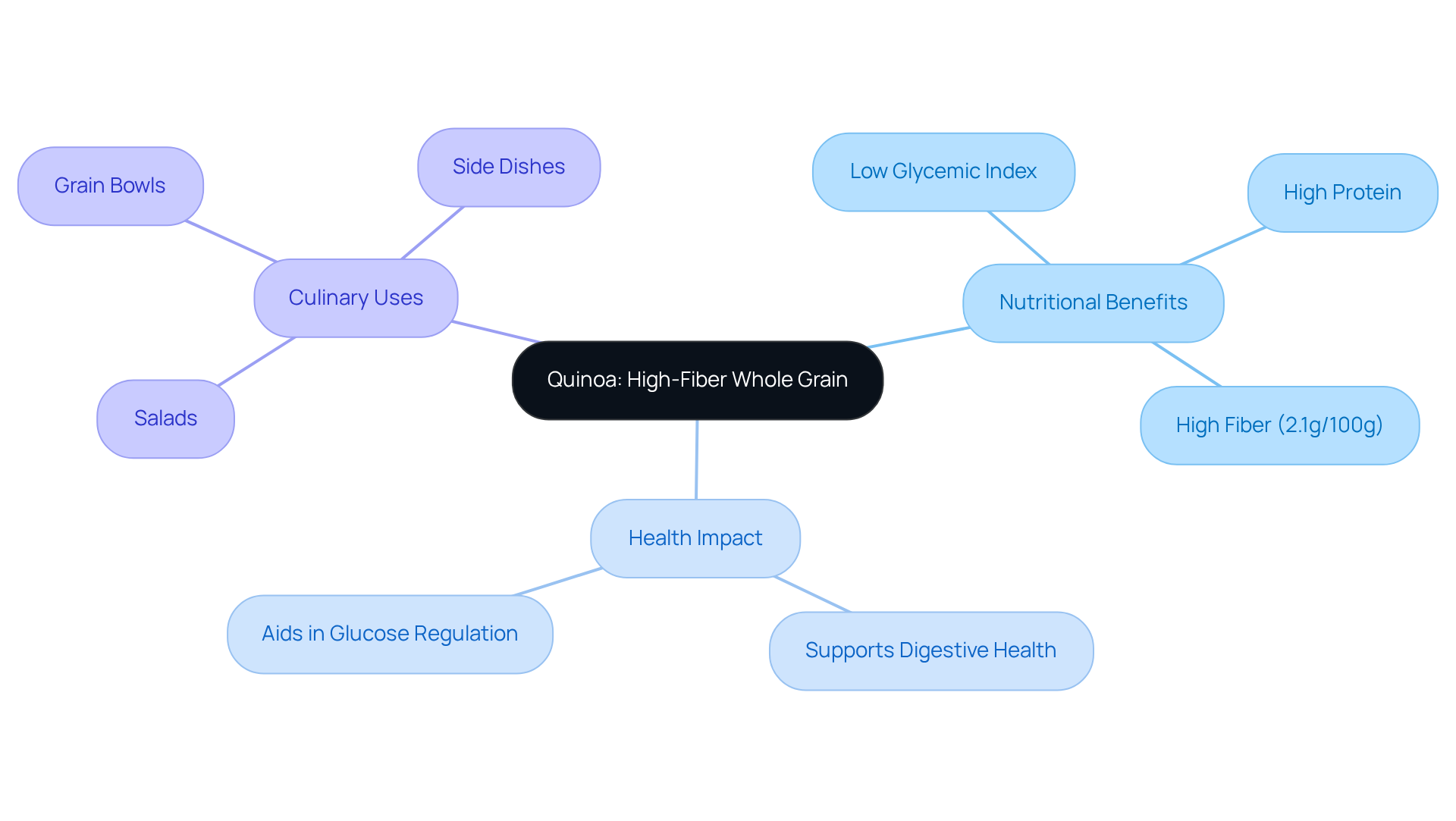
Almonds: Healthy Snack for Blood Sugar Regulation
Almonds are not just a snack; they are one of the foods that help type 2 diabetes, as they provide nutritious fats, fiber, and protein that can help you manage your glucose effectively. It's heartening to know that studies suggest consistent almond intake can lead to significant decreases in fasting glucose and insulin levels. For instance, research involving individuals with Type 2 Diabetes revealed that those who included almonds, which are considered among the foods that help type 2 diabetes, in their diet saw a meaningful reduction in hemoglobin A1c, a crucial marker for long-term glucose regulation.
Including a small handful of almonds in your daily snacks can provide essential nutrients and is one of the foods that help type 2 diabetes by preventing glucose spikes. Their high fiber content promotes feelings of fullness, which can be beneficial for weight management—a key factor since obesity is associated with a higher risk of developing Type 2 Diabetes and can be addressed by consuming foods that help type 2 diabetes. Furthermore, almonds are among the foods that help type 2 diabetes because of their low carbohydrate content, making them a smart choice for maintaining stable glucose levels.
At T2DSolutions, we understand how challenging managing Type 2 Diabetes can be, and we are here to provide you with comprehensive resources, including dietary recommendations. Nutritionists often recommend almonds as one of the foods that help type 2 diabetes because they can enhance satiety and help reduce overall calorie intake. With their rich nutrient profile, including vitamin E and magnesium, almonds are considered foods that help type 2 diabetes by supporting heart health and potentially lowering cholesterol levels, assisting you in keeping your blood sugar in check.
As part of a balanced diet, almonds are considered foods that help type 2 diabetes and can play a vital role in your journey toward better glucose regulation and overall health. Remember, you're not alone in this journey. Explore additional resources at T2DSolutions to discover how you can incorporate healthy foods like almonds into your health management plan.

Chickpeas: Fiber-Rich Legume for Diabetes Control
Chickpeas are considered one of the foods that help type 2 diabetes due to their excellent source of fiber and protein, which are vital for effectively regulating glucose levels. With 12.5 grams of fiber per cup, they are considered foods that help type 2 diabetes by slowing carbohydrate absorption into the bloodstream—this is particularly important for those managing high blood sugar. Furthermore, their low glycemic index, rated at 28, makes them among the foods that help type 2 diabetes, promoting a gentle rise in glucose levels rather than sharp spikes.
At T2DSolutions, we understand the challenges you may face in managing Type 2 conditions. We are committed to providing comprehensive resources, including dietary advice featuring nutritious foods like chickpeas. Recent studies have illuminated the significant benefits of chickpeas as one of the foods that help type 2 diabetes in controlling blood sugar levels. For example, research shows that chickpeas are one of the foods that help type 2 diabetes, as meals including them can result in a 25% lower glucose response compared to traditional high-carb options such as white bread. This is due to their unique composition, which includes resistant starch and soluble fiber that support improved glycemic control.
Nutritionists often recommend incorporating legumes like chickpeas, which are among the foods that help type 2 diabetes, into the diets of individuals with high blood sugar. These legumes not only enhance feelings of fullness but also assist in weight management—key factors in managing your health. Adding chickpeas to various dishes, whether in salads, soups, or as a hummus dip, not only boosts flavor but also enriches nutritional value, making meals more satisfying and healthful.
Current statistics indicate a growing trend in chickpea consumption among those with diabetes, with their popularity rising significantly in recent years. This increase is attributed to their affordability, versatility, and impressive nutritional profile, making them an accessible option for anyone looking to improve their dietary habits.
In summary, chickpeas are one of the foods that help type 2 diabetes management, offering numerous benefits that support glucose regulation and overall well-being. However, it’s crucial for individuals with diabetes to consult their doctor before incorporating chickpeas into their diet to ensure it aligns with their unique health needs. For more advice and resources on managing blood sugar levels, we invite you to visit T2DSolutions. Remember, you're not alone in this journey—we are here to support you every step of the way.
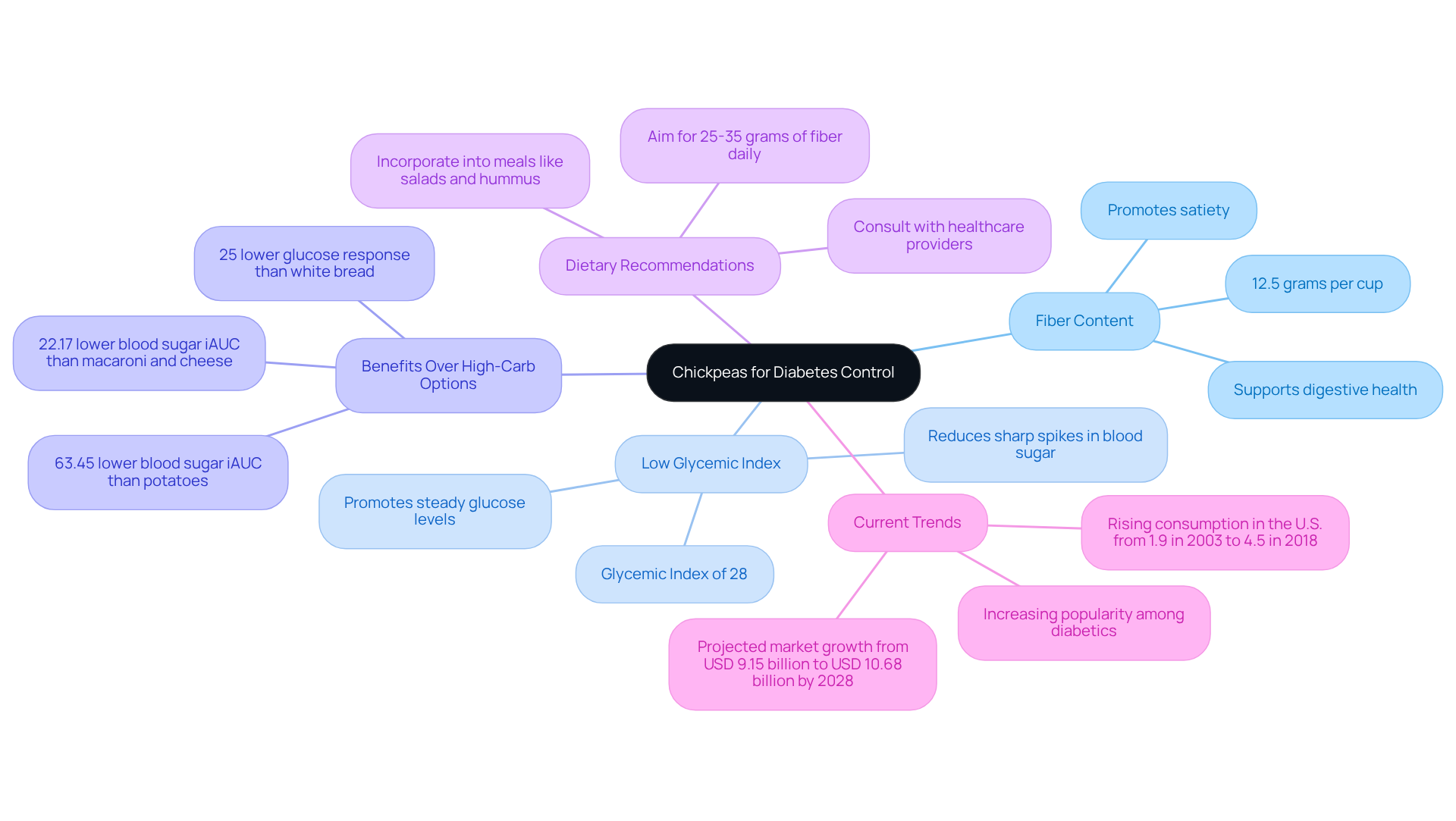
Greek Yogurt: Protein-Packed Dairy for Blood Sugar Management
Greek yogurt is not just a protein-rich dairy product; it's a nurturing choice that contains probiotics, which can improve gut health and potentially enhance insulin sensitivity. Choosing unsweetened Greek yogurt can be a wonderful option for a healthy snack or breakfast, helping you manage glucose levels effectively. You might enjoy pairing it with berries or nuts for added flavor and nutrients that support your well-being.
Recent studies have shown that regular consumption of yogurt is associated with a pooled hazard ratio of 0.82 for lowering the risk of Type 2 Diabetes. This makes it a valuable addition to the foods that help type 2 diabetes in a diabetes-friendly diet. Nutritionists, including Dr. Sanchari Sinha Dutta, emphasize that existing scientific evidence suggests that yogurt is among the foods that help type 2 diabetes and could be advantageous for the prevention and management of both blood sugar issues and obesity. This reinforces the idea that incorporating Greek yogurt into your daily meals can be a positive step.
You're not alone in this journey toward better health. Many find comfort in knowing that small dietary changes can lead to significant benefits. Consider making Greek yogurt a part of your routine, and remember, we are here to support you every step of the way.
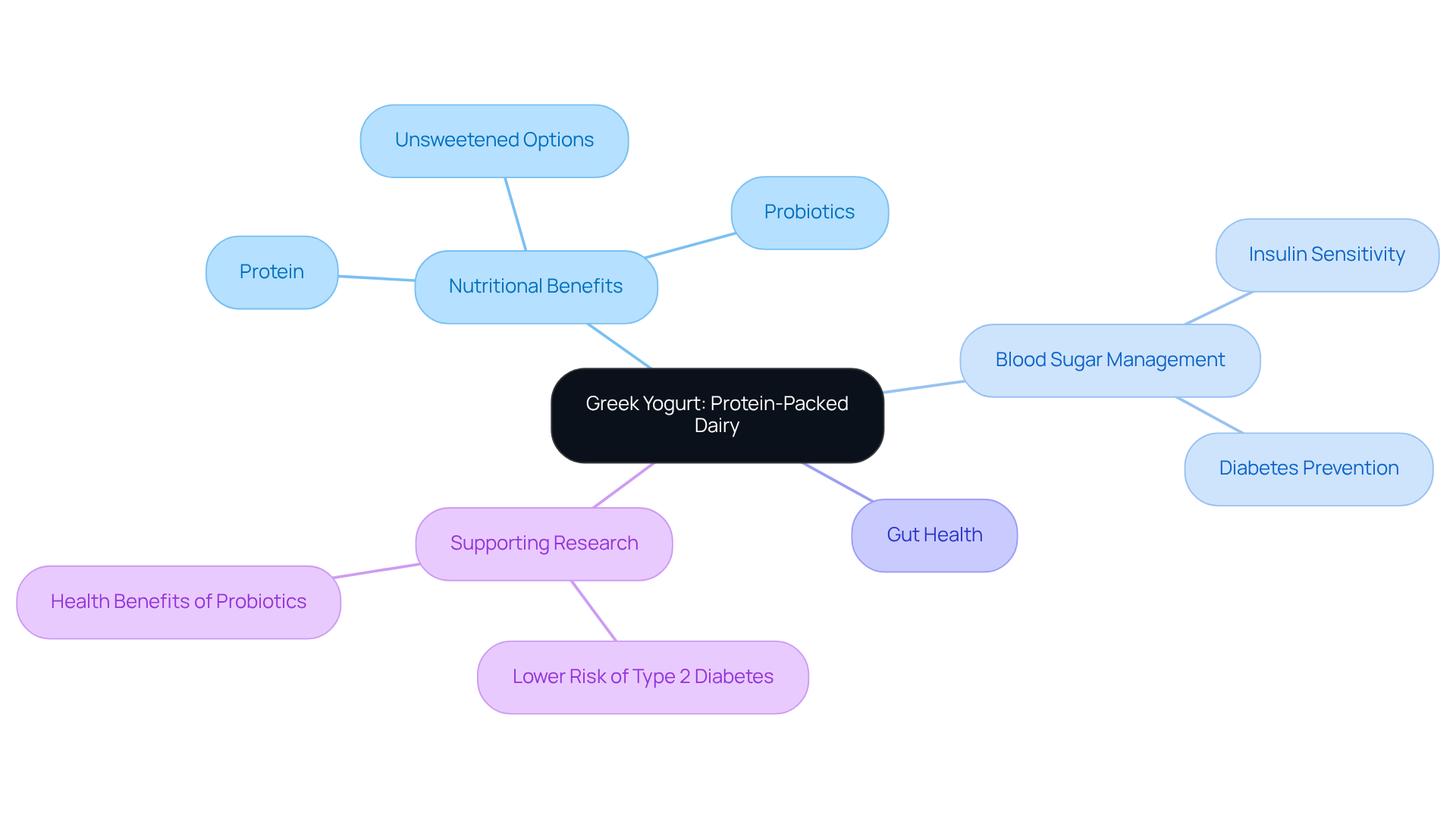
Sweet Potatoes: Low Glycemic Index Carbohydrate for Diabetes
Sweet potatoes are a wonderful source of nutrients, offering a carbohydrate option that is both healthy and satisfying. With a glycemic index of around 63, they are significantly lower than regular potatoes, which have an index of approximately 78. This means sweet potatoes are considered foods that help type 2 diabetes because they can lead to a slower increase in glucose levels, making them an excellent choice for those looking to manage their condition. They are rich in vitamins A and C, potassium, and dietary fiber, making them essential foods that help type 2 diabetes by regulating blood sugar and supporting overall health. Incorporating sweet potatoes into your meals can improve your immune function and help you feel full, which is important for weight control—a key aspect of managing blood sugar levels with foods that help type 2 diabetes.
Recent studies show that sweet potatoes are one of the foods that help type 2 diabetes and can lead to better glycemic control when added to your diet. Some research even indicates a statistically significant reduction in glycosylated hemoglobin A1c (HbA1c) levels among participants who consumed higher amounts of sweet potato preparations. Nutritionists recommend sweet potatoes as a satisfying and nutritious alternative to higher glycemic foods, emphasizing their significance as one of the foods that help type 2 diabetes in a balanced diet for blood sugar management.
For those who are newly diagnosed, it’s understandable to feel overwhelmed. T2DSolutions offers meal planning resources that include delicious sweet potato recipes, making it easier to incorporate this nutritious food into your diet. You're not alone in this journey—explore T2DSolutions for additional tips and community support as you navigate managing your diabetes.

Cinnamon: Spice for Enhancing Insulin Sensitivity
Cinnamon: A Caring Spice for Enhancing Insulin Sensitivity
Cinnamon is a versatile spice that many people find comforting, and it holds the potential to enhance insulin sensitivity and lower blood sugar levels. At T2DSolutions, we are dedicated to providing you with valuable resources for managing Type 2 Diabetes. By adding cinnamon to your meals or drinks, you not only enhance the flavor but also include foods that help type 2 diabetes in your diabetes-friendly diet without needing extra sweeteners.
Research shows that consistent cinnamon intake can significantly lower fasting glucose levels and improve overall glycemic management. For instance, in a study involving 109 patients with Type 2 Diabetes Mellitus (T2DM), cinnamon lowered hemoglobin A1c (HbA1c) by 0.83% compared to only 0.37% in usual care alone. Nutritionists highlight the importance of spices like cinnamon as foods that help type 2 diabetes in diabetes management, noting their ability to mimic insulin's effects and enhance glucose metabolism.
Moreover, cinnamon is considered one of the foods that help type 2 diabetes as it has been shown to improve insulin sensitivity by more than 20-fold compared to other tested compounds, making it a valuable ally in your journey against the condition. Recent studies continue to support these findings, showing that cinnamon not only aids in blood sugar regulation but also contributes to overall metabolic health. For example, a study involving 22 subjects with metabolic syndrome demonstrated decreased fasting blood glucose and increased lean mass.
However, it's important to be mindful of high doses of cinnamon, especially from the Cassia variety, as they may pose risks such as liver damage due to coumarin content. Therefore, opting for Ceylon cinnamon, which has lower coumarin levels, is advisable if you’re looking to incorporate this spice into your diet.
You're not alone in this journey. For more insights and resources on managing diabetes through diet, we invite you to explore T2DSolutions. We are here to support you every step of the way.
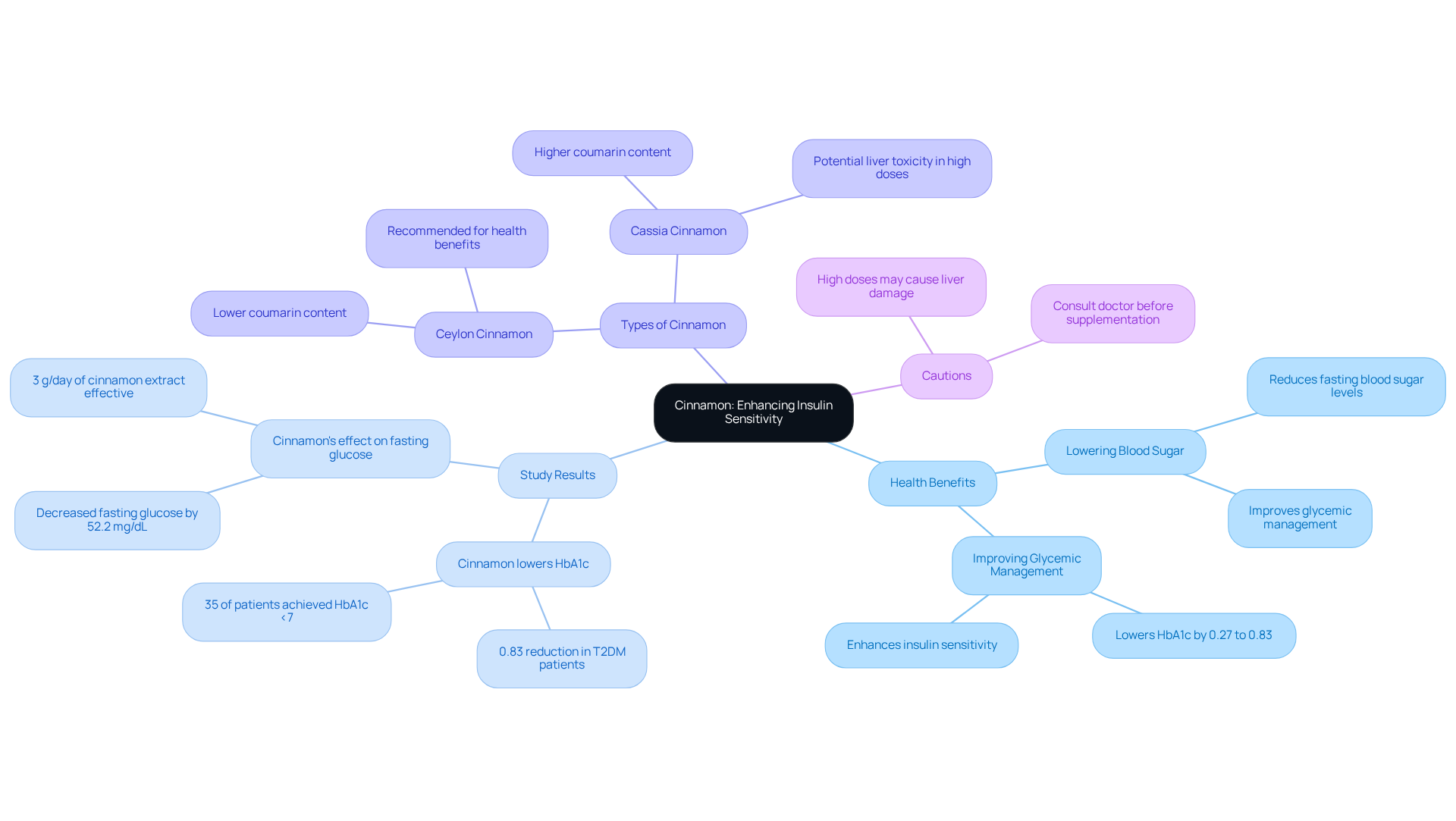
Conclusion
Incorporating the right foods into your diet can significantly enhance the management of Type 2 Diabetes. Not only do these foods provide nutritional benefits, but they also empower you on your journey with this condition. This article highlights ten specific foods that are beneficial for blood sugar control and contribute to your overall health and well-being. By focusing on nutrient-dense options like:
- Spinach
- Blueberries
- Salmon
- Quinoa
- Almonds
- Chickpeas
- Greek yogurt
- Sweet potatoes
- Cinnamon
you can make informed dietary choices that align with your health goals.
Each of these foods offers unique advantages. Spinach is packed with essential vitamins and antioxidants, while blueberries are rich in nutrients that improve insulin sensitivity. Salmon contributes heart-healthy omega-3 fatty acids, and quinoa serves as a high-fiber grain that stabilizes blood sugar levels. Almonds and chickpeas are excellent sources of protein and fiber, aiding in glucose regulation. Greek yogurt provides probiotics for gut health, sweet potatoes offer a lower glycemic index option, and cinnamon enhances insulin sensitivity. Together, these foods create a balanced approach to managing Type 2 Diabetes.
It’s understandable that the journey of managing diabetes can often feel isolating. Recognizing the importance of community and resources, like T2DSolutions, is crucial as they provide guidance and support. Embracing these dietary changes not only fosters better blood sugar control but also encourages a healthier lifestyle overall. By taking proactive steps and exploring the wealth of information available, you can navigate your health journey with confidence and resilience. Remember, you’re not alone in this journey; we are here to support you every step of the way.
Frequently Asked Questions
What is T2DSolutions?
T2DSolutions is a platform dedicated to empowering individuals and families affected by Type 2 Diabetes, offering resources for blood sugar management education and community support.
What types of information does T2DSolutions provide?
T2DSolutions offers tailored information on dietary plans, exercise routines, foods that help manage Type 2 diabetes, and the latest medical research.
How does T2DSolutions support individuals managing Type 2 Diabetes?
T2DSolutions focuses on a holistic approach that includes lifestyle changes and community support, helping individuals navigate the complexities of diabetes management.
Why is spinach beneficial for those with Type 2 Diabetes?
Spinach is low in calories and carbohydrates, high in fiber, and packed with essential nutrients. It can improve insulin sensitivity and help reduce the risk of sugar spikes.
Are there any precautions to consider when consuming spinach?
Individuals prone to kidney stones or on anticoagulants should be cautious due to spinach's high oxalate content and vitamin K levels.
What are the health benefits of blueberries for diabetes management?
Blueberries have a low glycemic index and are rich in antioxidants, which can improve insulin sensitivity and help manage glucose levels.
How many blueberries should one include in their diet for diabetes management?
Including approximately 1 cup of fresh or frozen blueberries in daily meals can support glucose management and overall health.
What resources does T2DSolutions offer for community support?
T2DSolutions encourages individuals to connect with others who share similar experiences, fostering a supportive community for those managing diabetes.



